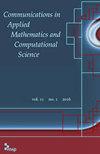关于光谱延迟校正方法的收敛性
IF 2.1
3区 数学
Q1 MATHEMATICS, APPLIED
Communications in Applied Mathematics and Computational Science
Pub Date : 2017-06-20
DOI:10.2140/camcos.2019.14.33
引用次数: 16
摘要
在这项工作中,我们分析了Dutt等人最初提出的光谱延迟校正(SDC)方法的收敛特性[BIT, 40 (2000), pp. 241—266]。这种高阶常微分方程(ODE)求解器的框架通常是这样描述的,其中通过对误差方程应用相同的低阶方法,然后添加导致的缺陷来纠正解决方案,将低阶近似(例如前向或后向欧拉)提升到更高阶精度。我们的重点不是解决误差方程以提高精度的阶数,而是将求解器重写为迭代皮卡德积分方程求解器。在这样做的过程中,我们的主要发现是,它不是低阶解算器在每次修正时拾取精度的顺序,而是右侧函数的基本正交规则,它单独负责拾取额外的精度顺序。我们的证明指出SDC方法总共有三种误差来源:当前时间点的误差,以前迭代的误差,以及来自用于积分的正交节点总数的数值积分误差。这两个误差来源中的第二个是SDC方法与皮卡德积分方程方法的区别;我们的研究结果表明,只要当前迭代和之前迭代之间的差异总是乘以至少一个时间步长的常数倍,那么即使底层“解算器”与底层ODE不一致,也可以找到高阶精度。从这一优势出发,我们巩固了将光谱延迟校正方法扩展到更大类求解器的前景,我们提出了一些例子。本文章由计算机程序翻译,如有差异,请以英文原文为准。
On the convergence of spectral deferred correction methods
In this work we analyze the convergence properties of the Spectral Deferred Correction (SDC) method originally proposed by Dutt et al. [BIT, 40 (2000), pp. 241--266]. The framework for this high-order ordinary differential equation (ODE) solver is typically described wherein a low-order approximation (such as forward or backward Euler) is lifted to higher order accuracy by applying the same low-order method to an error equation and then adding in the resulting defect to correct the solution. Our focus is not on solving the error equation to increase the order of accuracy, but on rewriting the solver as an iterative Picard integral equation solver. In doing so, our chief finding is that it is not the low-order solver that picks up the order of accuracy with each correction, but it is the underlying quadrature rule of the right hand side function that is solely responsible for picking up additional orders of accuracy. Our proofs point to a total of three sources of errors that SDC methods carry: the error at the current time point, the error from the previous iterate, and the numerical integration error that comes from the total number of quadrature nodes used for integration. The second of these two sources of errors is what separates SDC methods from Picard integral equation methods; our findings indicate that as long as difference between the current and previous iterate always gets multiplied by at least a constant multiple of the time step size, then high-order accuracy can be found even if the underlying "solver" is inconsistent the underlying ODE. From this vantage, we solidify the prospects of extending spectral deferred correction methods to a larger class of solvers to which we present some examples.
求助全文
通过发布文献求助,成功后即可免费获取论文全文。
去求助
来源期刊

Communications in Applied Mathematics and Computational Science
MATHEMATICS, APPLIED-PHYSICS, MATHEMATICAL
CiteScore
3.50
自引率
0.00%
发文量
3
审稿时长
>12 weeks
期刊介绍:
CAMCoS accepts innovative papers in all areas where mathematics and applications interact. In particular, the journal welcomes papers where an idea is followed from beginning to end — from an abstract beginning to a piece of software, or from a computational observation to a mathematical theory.
 求助内容:
求助内容: 应助结果提醒方式:
应助结果提醒方式:


